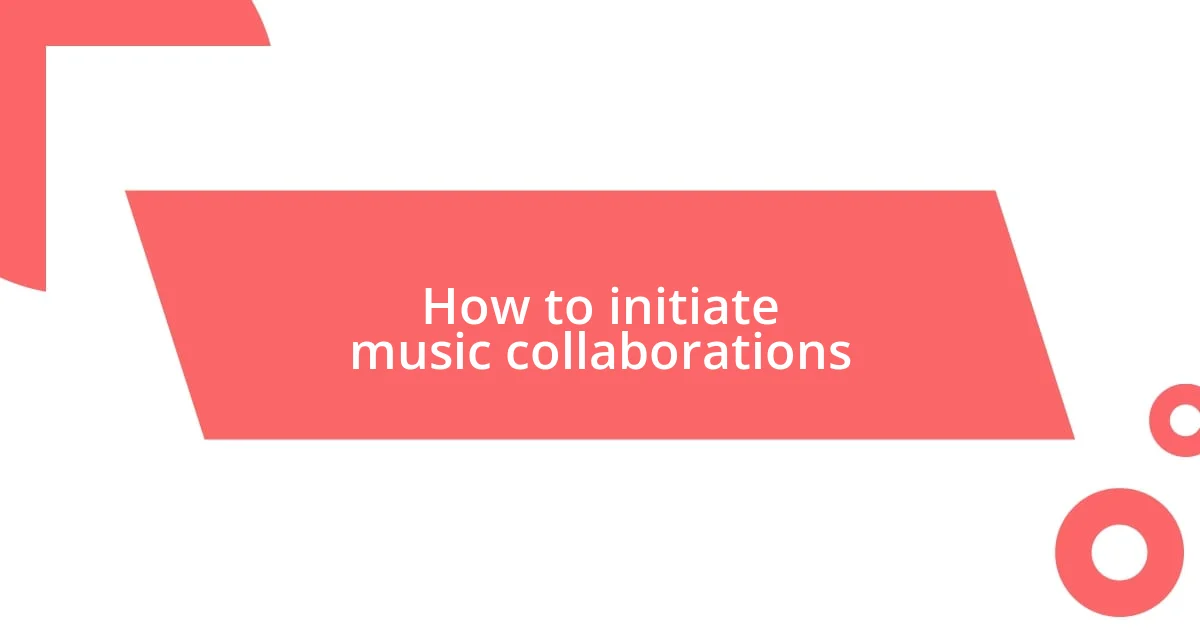Key takeaways:
- Music collaborations enhance creativity by merging diverse styles and expanding audience reach, leading to groundbreaking innovations.
- Challenges such as differing creative visions, logistical issues, and emotional vulnerabilities can complicate successful partnerships.
- Future trends in collaborations include increased genre-blending, remote partnerships powered by technology, and a focus on social impact initiatives.

The importance of music collaborations
Collaborations in music are more than just joining forces; they bring fresh perspectives and unique sounds that can propel artists to new heights. I remember the excitement I felt when hearing the seamless blend of rap and country in a hit song—two worlds colliding in ways I never imagined! It made me wonder, how many creative boundaries can be broken when diverse talents come together?
When I reflect on my favorite musical moments, they often involve unexpected duets or partnerships. For instance, think about when an indie artist teams up with a mainstream pop star. It’s fascinating how these collaborations can introduce entire audiences to different genres, sparking curiosity and appreciation. Isn’t it remarkable how one collaboration can change the trajectory of an artist’s career?
Moreover, collaborations serve as a powerful tool for storytelling. Each artist brings their own experiences and emotions to the table, weaving a tapestry that resonates more deeply with listeners. I’ve found that songs born from collaboration often strike a chord within me, highlighting the shared human experience in ways solo efforts sometimes can’t. How do you think these emotional connections impact our appreciation of music?

Types of collaborations in music
Collaborations in music can take various forms, each bringing something unique to the table. For example, I’ve noticed how feature collaborations allow artists to blend their distinct styles while reaching new audiences. Remember that time when a hip-hop artist featured on a pop anthem? It was electrifying to see fans from both genres come together, creating a beautifully diverse celebration of music.
Another type is the genre fusion collaboration, where artists from differing backgrounds merge their sounds. I often think of collaborations that bring together electronic beats with acoustic elements. Hearing a folk singer layer their voice over a pulsating electronic track completely transformed my perception of what’s possible in music. It’s like venturing into the unknown, with every note carrying the promise of something extraordinary.
Lastly, we have the collaborative albums, which are intimate journeys through multiple artists’ visions. I recall listening to a project where various artists contributed tracks that resonated with me in deep ways. Each collaboration added a new layer of depth, making the whole experience feel like a rich tapestry rather than just a collection of songs. Isn’t it fascinating how these different types of collaboration challenge our understanding and appreciation of music?
| Type of Collaboration | Description |
|---|---|
| Feature Collaborations | Artists from different genres collaborate on a single track, often blending unique styles. |
| Genre Fusion | Combines two or more musical genres to create innovative soundscapes. |
| Collaborative Albums | Multiple artists work together on a project, creating a cohesive experience. |

Benefits of collaborating with artists
Collaborating with other artists can lead to groundbreaking discoveries and innovations. I still remember the thrill of hearing my favorite electronic artist partner with a renowned jazz musician. The combination created a sound I had never experienced before. It made me realize that stepping outside our comfort zones can yield incredible creativity.
Here are some benefits that collaborations offer:
- Expanded Audience Reach: When artists team up, they attract each other’s fan bases, effectively multiplying their reach.
- Creative Inspiration: Working with others can spark new ideas and approaches, helping artists explore untapped creative avenues.
- Skill Enhancement: Collaborators often learn from one another, enhancing their musical technique and broadening their artistic capabilities.
- Emotional Connectivity: Each artist brings personal narratives to the table, creating songs that resonate deeply with a broader audience.
- Innovation: The fusion of differing styles and genres can lead to the birth of entirely new music styles, pushing the boundaries of what we consider possible.
Each collaboration has the potential to create something completely fresh and exciting. It’s a beautiful reminder of the power of music to bring people and ideas together.

Challenges faced in music collaborations
Working on music collaborations can be a double-edged sword. I’ve witnessed firsthand how differences in creative vision can create tension. Take, for instance, a project where two artists had distinctly divergent ideas about the track’s direction. It led to frustrating back-and-forth sessions, leaving both parties feeling unheard. How often have we seen a promising partnership falter due to a lack of compromise?
Additionally, logistics can pose significant challenges. I remember collaborating on a song where coordinating schedules felt like herding cats. Between busy tour dates and studio availability, it became a challenge just to be in the same room. It leaves me wondering, are artists sacrificing meaningful collaboration for the sake of convenience?
Lastly, there’s the emotional layer that can complicate these partnerships. I’ve recognized that pouring personal experiences into a collaborative project means opening up to vulnerability. When one artist holds back on sharing their story, it can stifle the emotional connection that makes music resonate. Have you ever felt a collaboration fall flat because one party simply didn’t commit to the emotional journey?

Successful examples of music collaborations
When I think of successful music collaborations, one standout example has to be the partnership between Dua Lipa and Elton John on their remix of “Cold Heart.” This collaboration not only blended their unique styles but also introduced Elton’s classic sound to a new generation. It reminded me of the sheer joy I felt when hearing their voices intertwine—it was refreshing, innovative, and a brilliant example of how different eras can create something magical together.
Another impressive collaboration is the track “Sicko Mode” by Travis Scott featuring Drake. The song took the world by storm, showcasing how two artists can elevate each other’s work through their distinct artistry. I vividly remember how it dominated playlists and sparked conversations everywhere. It’s a clear example of how powerful storytelling and diverse musical styles can engage a wide audience, creating a cultural phenomenon.
Then there’s “Say Something” by Justin Timberlake featuring Chris Stapleton, which beautifully married pop and country music. The raw emotions conveyed through their voices gave me chills the first time I listened to it. What really struck me was how their individual narratives blended seamlessly, producing a song that felt both personal and universally relatable. Have you ever experienced a collaboration that just clicked, making you appreciate the power of diverse voices working in harmony?

Future trends in music collaborations
The future of music collaborations is likely to be shaped heavily by technology. I’ve seen how digital platforms are making it easier for artists from different corners of the globe to create music together, often without ever stepping foot in the same studio. Imagine collaborating with someone in another country simply through a shared online workspace; it’s fascinating to think about how technology breaks down barriers. Have you ever collaborated on a project remotely? The possibilities are endless, and it opens doors to fresh influences and a fusion of various musical styles.
As I look ahead, I also see a trend toward more genre-blending collaborations. Artists are becoming increasingly adventurous, stepping outside their comfort zones. I recall a track that fused hip-hop with traditional folk music—I was blown away by how the elements came together to create something entirely new. This kind of experimentation allows for richer storytelling and creativity. Are we witnessing a societal shift where listeners now crave this innovative approach to music? It feels like the boundaries are finally starting to dissolve.
Moreover, there’s a growing emphasis on collaborations that prioritize social impact. Musicians are embracing partnerships to raise awareness on pressing issues, and that resonates deeply with me. For example, I remember a charity concert where diverse artists came together, each sharing their unique stories about social justice. That experience reminded me that music has a powerful ability to unify. Could this be the future direction of collaborations—not only focusing on the music but also on making a meaningful statement? It certainly feels like a promising path ahead.

How to initiate music collaborations
Reaching out for a potential music collaboration can feel daunting, but it’s essential to start with genuine enthusiasm. I remember the first time I approached another artist, a local singer-songwriter I admired—I simply sent a heartfelt message expressing my love for their work and suggesting we jam together. That initial outreach opened doors and reminded me how impactful a sincere compliment can be; it creates a foundation for trust and mutual respect.
Once you’ve made the connection, it helps to share your vision clearly. I once collaborated with a producer after sketching out our ideas in a casual brainstorming session. It was enlightening to see how openly discussing our creative goals fostered a collaborative spirit. Have you ever had a conversation that sparked inspiration? This back-and-forth dialogue can lay the groundwork for something truly unique, blending your influences and styles into a new piece of art.
Lastly, don’t underestimate the power of social media in initiating collaborations. I once followed an artist on Instagram, interacted with their posts, and eventually slid into their DMs to propose a project that merged our styles. That leap of faith not only led to a rewarding musical experience but also expanded my network significantly. It’s incredible how a simple click can lead to profound musical relationships—have you dared to make that leap? The digital world offers endless possibilities that can turn a fleeting thought into a collaborative reality.















